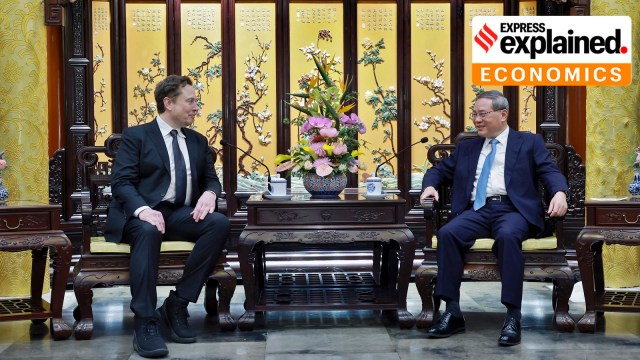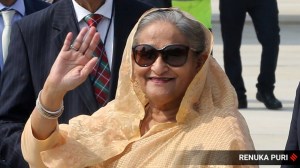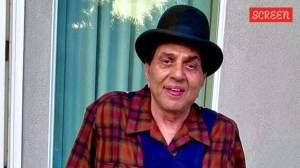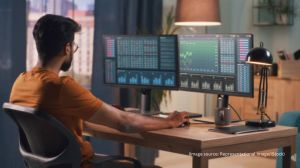Tesla CEO Elon Musk is reported to have won tentative approval for introducing Full Self-Driving (FSD) in China, clearing key administrative roadblocks in Beijing after meeting with top government officials. Musk landed in China on a surprise visit on Sunday (April 28), barely a week after he cited Tesla-related “obligations” to defer his much-anticipated India visit to meet Prime Minister Narendra Modi and founders of an Indian Space startup.

It is also grappling with sliding sales in China, where homegrown competitors are matching up to Tesla in most respects.
Story continues below this ad
On Sunday, Musk met with China Premier Li Qiang. Li said Tesla’s growth in China is “a successful example of Sino-U.S. economic and trade cooperation”, the Chinese state broadcaster reported. Tesla is likely to continue teaming up with the Chinese tech company Baidu, which licences mapping data and its lane-level navigation service for FSD. Tesla has been using Baidu for in-car mapping and navigation since 2020.
What is unclear, though, is if the Baidu deal means that Tesla could be disallowed from exporting FSD data from China back to the US, something that Musk has been strongly pushing for. On Tesla’s April 23 earnings call, Musk had said the EV major aims to release FSD “as a supervised autonomy system in any market that — where we can get regulatory approval for that, which we think includes China.”
FSD, and how the China deal helps Tesla
FSD is the most autonomous version of what’s called advanced driver assistance system or ADAS, a feature that enhances safety and convenience behind the wheel and that most vehicle makers are now beginning to offer as standard in their premium models.
Each new Tesla vehicle is equipped with multiple external cameras and vision processing software, which the company uses to deliver what’s called ‘Autopilot’ features – essentially an advanced ADAS suite trademarked by Tesla.
Story continues below this ad
Autopilot comes as standard on new Teslas and for owners who took delivery of their vehicle without this feature, there are multiple packages available for purchase depending on when the vehicle was built.
Tesla claims Autopilot and FSD “are intended for use with a fully attentive driver, who has their hands on the wheel and is prepared to take over at any moment”.
While these features are designed to become more capable over time, the company underlines that the currently-enabled features do not make the vehicle autonomous, even as it has been named the features Autopilot and FSD, both terms giving the impression the capabilities are far more accomplished than what they can actually achieve in real driving conditions. This aspect is also part of a broader regulatory review in the US.
Autopilot includes what Tesla calls ‘Traffic-Aware Cruise Control’, which matches the speed of the vehicle to that of the surrounding traffic, and ‘Autosteer’, a function that assists in steering within a clearly marked lane, and uses traffic-aware cruise control. FSD, on the other hand, is a further upgrade to Autopilot that was launched in 2020 and aims at a driving experience involving minimal driver intervention.
Story continues below this ad
In addition to the functionality and features of Autopilot, Tesla’s FSD capability also includes navigating on Autopilot, which actively guides the vehicle from a highway’s on-ramp to off-ramp.
It includes suggesting lane changes, navigating interchanges, automatically engaging the turn signal and taking the correct exit; ‘Auto Lane Change’, which assists in moving to an adjacent lane on the highway when Autosteer is engaged; ‘Autopark’, which helps automatically parallel or perpendicular park of the vehicle, with a single touch; a ‘Summon’ feature, which moves the vehicle in and out of a tight space using the mobile app or key; and ‘Stop Sign Control’, which identifies stop signs and traffic lights and automatically slows the vehicle to a stop on approach. Tesla vehicles are continuously upgraded on these features through over-the-air software updates.
The FSD rollout in China would allow Tesla to better compete with Chinese rivals in the world’s largest auto market, where driver assistance is offered as a premium feature. A rollout of unlimited FSD could help Tesla regain lost ground, given its longer expertise in deploying driver assistance features.
Problems with Full Self Driving tech
Every single year since 2014, Musk has promised that the Austin-based carmaker will get its self-driving technology road-ready, with a definitive time-frame for this upshift in passenger car technology. And each of these last ten years, what is evident is that self-driving continues to be as elusive for Tesla as it is for a bunch of other carmakers in the fray that aim to put passenger cars on the roads without anyone behind the wheels.
Story continues below this ad
Problems ranged from jumping red lights, not recognising pedestrians to situational problems like identifying a cyclist who briefly disappears behind a parked vehicle. Ultimately, Tesla began beta testing its full self-driving system only in 2020.
But there’s a catch with Tesla’s beta testing: it is doing the testing with regular people driving their Tesla cars on public roads, with each of these drivers having forked out an amount of $12,000 for the privilege of doing so. The FSD clearance in China is therefore quite significant, given that it could mean a majority of more than 1.7 million Tesla car owners in that country could potentially deploy one or the other variants of the ADAS technology, which could yield more revenues and a trove of driver data for the carmaker.
It’s not Tesla alone. Google’s Waymo and Cruise owned by General Motors are among companies that predicted they’d have full self-driving cars by 2020, with only limited success: that too limited to ring fenced, geotagged areas. And there are perils of unleashing less-than-optimally tested tech: In June last year, for instance, 13 Cruise Robo taxis stopped simultaneously on a major arterial street in San Francisco, bringing traffic to a standstill.
Clearly, developing full self-driving cars is way harder than carmakers initially thought. Also, there is the continuing debate on the technology of choice: cameras vs a combination of technologies that include lidar, radar, sensors and camera.
Story continues below this ad
While Tesla is relying primarily on cameras, most other car models depend on multiple sensors to feed information into onboard computers, which expends huge amounts of processing power to map what’s going on and forecast what might happen next.
While it is easy for humans to do this kind of prediction based on situational awareness, this can present a complex problem for computers, such as when someone at the side of the road steps off the pavement and disappears behind a parked bus for a minute or distinguishing between a red signage on a wall versus an actual stop sign. In the first instance, a human driver might anticipate that the person behind the bus could emerge from the other side and step out onto the road.
In 2022, eight years after his first prediction, Musk highlighted the real scale of the problem – that to solve full self-driving, the issue of a mastery over real world AI is a must, which is still a work-in-progress. The rapid advances being made in large language models is a somewhat positive sign, going forward. But all the information the car will need to drive properly has to be aggregated by sensors or cameras and then fed into the computer for it to learn from it, which is possible only with increased autonomous driving miles.
As a result of these gaps, both car hiring majors Uber and Lyft are offloading their self driving divisions. Tesla has been sued for failing to deliver on Musk’s long standing promise to develop a fully self-driving car.
Story continues below this ad
The Insurance Institute for Highway Safety, a US-based industry funded group that prods automakers to make safer vehicles, released the findings of a survey in October than reported that regular users of Super Cruise, Nissan/Infiniti’s ProPILOT Assist and Tesla’s Autopilot “said they were more likely to perform non-driving-related activities like eating or texting while using their partial automation systems than while driving unassisted.”
Late Thursday, the National Highway Transportation Safety Administration said it was opening a new probe of Tesla self-driving systems amid concerns that a move last year to improve driver monitoring and attention was not up to the mark. An investigation has been opened into whether Tesla’s recall in December of more than 2 million vehicles in the US to install new Autopilot safeguards was adequate, following a number of crashes.








































